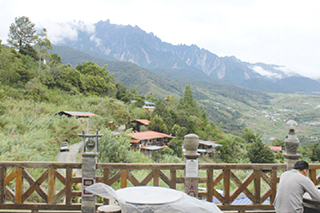Geologists' tales of Mt Kinabalu
Published on: Thursday, October 19, 2017
Kota Kinabalu: The rock of Mt Kinabalu originated in the Philippines.Peter Negrido, President and CEO of Philippines Rescue and Reconnaissance team, said he couldn't figure out how that could happen.But the late American geologist, Dale Brunotte, who died in March 2016 in Michigan, said that's the geological fact of the case. style="display:block; text-align:center;"
data-ad-layout="in-article"
data-ad-format="fluid"
data-ad-client="ca-pub-2225940078889583"
data-ad-slot="2484635331">
He said it all started with a cataclysmic geological event 15 million years ago when a micro plate sub-ducted (down going another plate) to 100km deep.
The superheated condition at that depth consumed huge chunks of rocks at the head of the sub-ducted plate, forming a massive ball of molten liquid magma and under huge pressure, migrated to Sabah where it lodged below the present site of Mt Kinabalu.
The magma cooled down and hardened about nine million years ago, noted Brunotte, a former lecturer at the now defunct Universiti Kebangsaan, who spoke fluent Bahasa Malaysia and Kadazan.
ADVERTISEMENT
Brunotte did not explain in detail how exactly this vertical uplift happened except citing plate tectonics as a driving force, noting that Sabah is near some very active convergent zones of massive colliding crustal plates like the Australian plate in the south, Pacific and the Philippines plate to the north east, the Eurasian plate to the west and possible others.
Tectonic pressure gradually lifted the consolidated rock which punched through the surface at the north-western end of the Crocker Range fault about one million years ago and the mountain is still rising slowly but surely, geologists say.
ADVERTISEMENT
Other geologists believe that when a weakened continental plate arrived at the dipping or down-going zones, it choked subduction about nine million years ago (mid Miocene) and caused isostatic uplift of the western cordillera (chain of mountain systems like Kinabalu, Tambuyukon and Trusmadi) of Sabah.
It is interesting to note that besides the Palawan Trench which proves that there was a subduction or down going plate that conceived the rock, chiefly quartz and feldspar of Kinabalu, there is another trench called the North Borneo Trough west of Sabah.
Interestingly, both the Palawan Trench and the North Borneo Trough are no longer active.
The geological story of Mt Kinabalu is a fascinating tale of planet earth's penchant to recycle its own materials to renew itself and in this case, the creation of a fabulous mountain for Sabah.
Today, geologists rate Mt Kinabalu the world's youngest pluton which, by definition, means a body of igneous rock formed beneath the surface of the earth by consolidation of magma.
From all accounts, the peaks of Kinabalu were initially vegetated.
Stay up-to-date by following Daily Express’s Telegram channel.
Daily Express Malaysia
However, during the last Ice Age which occurred between 110,000 and 11,700 years ago, the mountain was snow-capped under billion tonnes of ice.
Glacial movement from the snow scrapped the top bald of vegetation forming a barren rock summit. - Kan Yaw Chong




